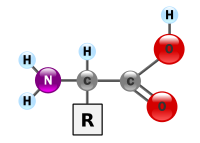
Photo from wikipedia
The question whether and which nonhuman peptides or proteins are present in human milk was raised many decades ago. However, due to cross-reactivity or nonspecific antibody recognition, the accuracy of… Click to show full abstract
The question whether and which nonhuman peptides or proteins are present in human milk was raised many decades ago. However, due to cross-reactivity or nonspecific antibody recognition, the accuracy of detection by immunochemical methods has been a concern. Additionally, the relative low-abundance of nonhuman peptides/proteins in the complex milk sample makes them a challenging target to detect. Here, by deep proteome profiling, we detected several nonhuman peptides, which could be grouped as nonhuman proteins. We next estimated their concentration in human milk by combining data-dependent shotgun proteomics and parallel reaction monitoring. First, we fractionated human milk at the protein level and were able to detect 1577 human proteins. Additionally, we identified 109 nonhuman peptides, of which 71 were grouped into 36 nonhuman proteins. In the next step, we targeted 37 nonhuman peptides and nine of them could be repeatedly quantified in human milk samples. Peptides/proteins originating from bovine milk products were the dominant nonhuman proteins observed, notably bovine caseins (α-S1-, α-S2-, β-, κ-caseins) and β-lactoglobulin. The method we present here can be expanded to investigate more about nonhuman peptides and proteins in human milk and give a better understanding of how human milk plays a role in allergy prevention.
Journal Title: Journal of Proteome Research
Year Published: 2019
Link to full text (if available)
Share on Social Media: Sign Up to like & get
recommendations!